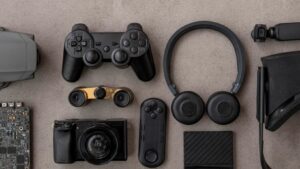From the sleek, covert devices seen in spy thrillers to the cutting-edge technology used by real-life intelligence agencies, high tech spy gadgets have long captured the public’s imagination. They’re not just the stuff of Hollywood fiction or government espionage anymore. In today’s digital age, these devices have become increasingly accessible to the average consumer.
Whether you’re a budding secret agent, a tech enthusiast, or simply curious about the world of espionage, this article will delve into the fascinating realm of high tech spy gadgets. We’ll explore the latest innovations, their practical applications, and how they’re transforming the landscape of personal and professional security. So, prepare to step into the shadows and discover the intriguing world of spy tech.
High Tech Spy Gadgets
 Sharing in the intrigue of high tech spy gadgets, this section delves deep into the varieties and the rapidly changing realm of this technology. High tech spy gadgets come in plenty of forms, blending into everyday objects for stealth whether it is for personal or professional use. Some commonly seen spy gadgets include:
Sharing in the intrigue of high tech spy gadgets, this section delves deep into the varieties and the rapidly changing realm of this technology. High tech spy gadgets come in plenty of forms, blending into everyday objects for stealth whether it is for personal or professional use. Some commonly seen spy gadgets include:
- Hidden Cameras: Disguised as ordinary objects like pens, clocks, or even smoke detectors, hidden cameras capture crucial footage unnoticed.
- GPS Trackers: Small and discreet, GPS trackers monitor and relay a vehicle’s whereabouts, aiding in complex investigations.
- Spy Watches: Doubling as regular wristwatches, these house video cameras, microphones, or GPS trackers.
- Voice Changer Devices: Alters a user’s voice, making them unidentifiable over calls or recordings.
- RF Signal Detectors: Scans for radio frequencies emitted by spy gadgets, especially useful to ensure privacy.
How High Tech Spy Gadgets Are Revolutionizing Intelligence
The advent of high tech spy gadgets leads intelligence into unexplored territories. It’s transforming the way data is collected and security is maintained. The use of nanotechnology in devices like cameras and microphones enables inconspicuous surveillance. Drones are extending their functional reach, providing aerial views without risking human operatives. CCTV systems, equipped with facial recognition, bolster public safety and criminal identification. Most importantly, the emergence of counter-surveillance gadgets like RF detectors and camera finders assures individuals and establishments of their privacy.
The influence of these gadgets on intelligence is profound, opening up possibilities while ensuring security, and their evolution in the coming years promises advancements that redefine current capabilities.
Key Features of Top Spy Gadgets
 Spy gadgets exhibit various standout features that set them apart in the realm of high-tech surveillance. Cameras form an essential part of spy gadgets. Miniaturization, an accomplished feat in nanotechnology, results in small, concealed cameras integrated into the most unexpected items. For instance, one might find a camera ingeniously hidden in pens, glasses, or even a tie. Innovative cameras, these capture high-resolution images, allowing precise data collection.
Spy gadgets exhibit various standout features that set them apart in the realm of high-tech surveillance. Cameras form an essential part of spy gadgets. Miniaturization, an accomplished feat in nanotechnology, results in small, concealed cameras integrated into the most unexpected items. For instance, one might find a camera ingeniously hidden in pens, glasses, or even a tie. Innovative cameras, these capture high-resolution images, allowing precise data collection.
Similarly, recording devices accomplish a discrete capture of audio data. Small, camouflaged in everyday objects like watches or calculators, these recorders catch every sound in their vicinity. A considerable example is the voice-activated recorders; these start recording automatically based on preset audio levels, ensuring seamless operation.
Accurate location tracking forms another crucial facet of spy gadgets. Making substantial use of Global Positioning System (GPS) technology, these devices provide real-time location updates. They’re often small, portable, and could be surreptitiously placed on objects or persons for continuous tracking. For instance, some advanced GPS trackers offer geofencing capabilities, alerting when the tracked object moves outside a predefined area.
Legal and Ethical Considerations
 In the realm of high-tech spy gadgets, intertwined are compelling issues of law and ethics. Technological advancements in this field foster vital conversations about their legal and ethical implications.
In the realm of high-tech spy gadgets, intertwined are compelling issues of law and ethics. Technological advancements in this field foster vital conversations about their legal and ethical implications.
Various legislative frameworks guard the sanctity of personal privacy, inclusive of constitutional provisions, federal and state statutes, and case law precedents. Wiretapping, eavesdropping, video surveillance, and GPS tracking, components integral to a number of spy gadgets, all fall within the purview of such laws. For instance, the federal Wiretap Act prohibits intentional capturing of oral, electronic, or wire communications without consent. Likewise, Video Voyeurism Prevention Act criminalizes clandestine recording in areas where one has a reasonable expectation of privacy. Contravention of these laws could lead to civil lawsuits, hefty fines, or even imprisonment.



